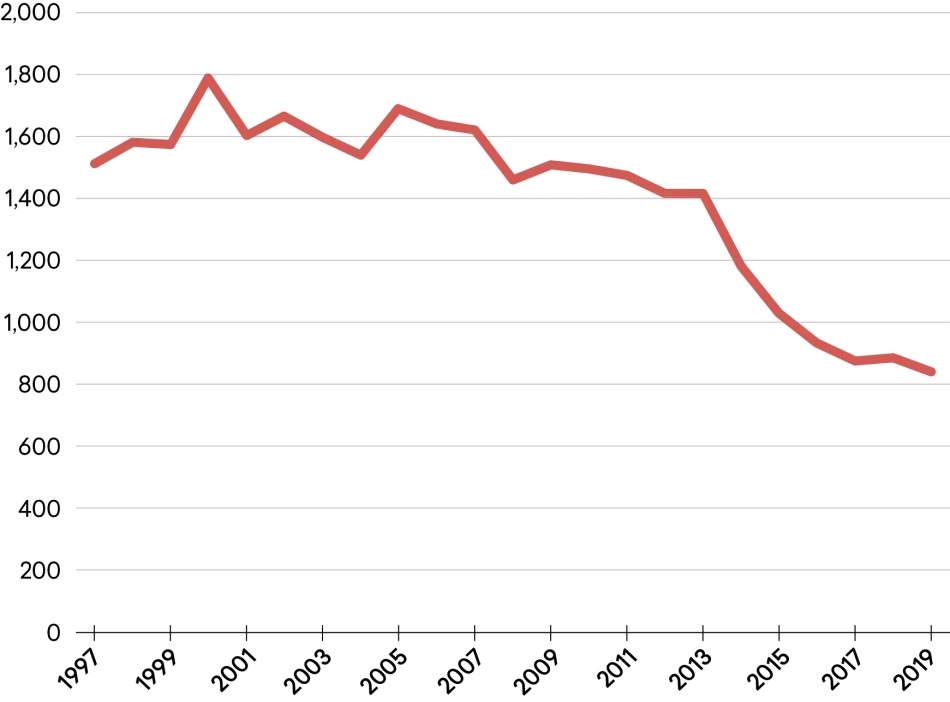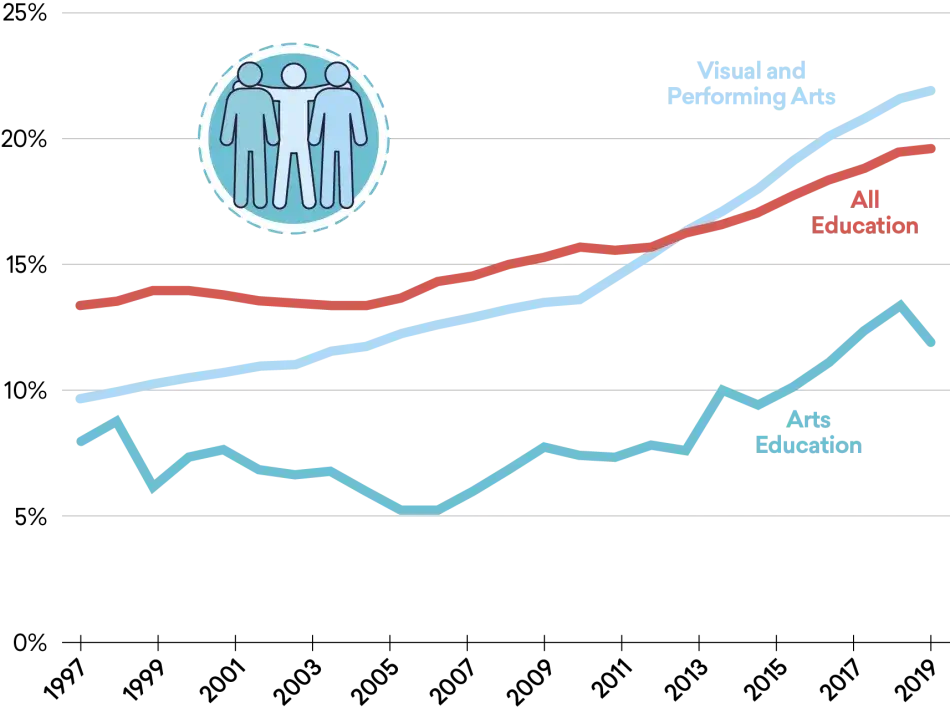Policy Recommendations
Access to a solid education in the arts should be as fundamental as teaching students to read, as the benefits extend to every stage of life. But putting the arts in their proper place in the education system will require substantial change at the federal, state, and local levels. To address these needs, we lay out a set of policy recommendations to strengthen arts education through six key approaches: 1) Making the arts a vital part of every child’s education; 2) Elevating the role of the arts through data, research, and accountability systems; 3) Ensuring arts education funding is adequate and equitable; 4) Recruiting, developing, and supporting arts educators; 5) Expanding arts education collaboration and partnerships within the arts education ecosystem; and 6) Restoring federal leadership in the arts

“[Arts education] is not about developing the next Picasso or Kahlo. It is about developing thinkers that see the world through a different lens. It is about developing thinkers to express emotions inspired by the world around them. It is about developing thinkers who challenge the status quo.”
—Jason, Visual Arts Educator, Ohio
Make the Arts an Important Part of Every Child’s Education
The value of a quality arts education is clear, but the commitment to the subject—in both funding and course requirements—remains precarious at best. Given that, we call on states and localities to recognize the value of the arts, ensure a diverse set of classes is offered, fully fund those classes, and encourage students to take a range of courses by including arts among the core distribution requirements.
Ensure a Diverse Set of Course Offerings
The arts comprise a broad and diverse set of subjects. While some students will respond to one form—such as music—others will find their talents lead toward other forms of artistic expression—perhaps media arts or sculpture. Given that, it is not sufficient for a school to offer only one or two types of classes. State and local systems should recognize this diversity and ensure that students can have full exposure to a diverse set of courses in the field. These courses should also reflect the diversity of art forms by including cultural heritage and arts creation beyond a narrow Eurocentric arts canon.
Provide Proper Funding for Arts Classes
If students are to have access to a quality arts education, their classes must be fully and properly funded. This is particularly true at Title I schools, where asking students to pay for or subsidize the materials necessary for learning is simply unacceptable. Arts teachers (like other teachers) also often pay for some materials out of their own pockets.51 Funding for arts supplies and equipment is often unreliable and subject to cuts.52 Tools and resources from Americans for the Arts provide indispensable material for parents, teachers, administrators, and other community leaders trying to make the case for support, and we encourage everyone with an interest to get informed and get active in their communities.53
Make (or Retain) Arts Requirements
In our various listening sessions, we heard from children and adults who gained valuable experiences and skills through arts courses, many of whom would have taken more arts courses had they been core courses or required courses. Even though forty-four states required districts or schools to offer arts education as of 2018, only twenty states included arts courses as an option to fulfill graduation requirements.54 We note with particular regret that some states seem intent on watering down or eliminating their course requirements. As this report was being finalized, for instance, a bill was introduced in the Texas state legislature that would make the already modest arts requirement at the high school level (for just a single credit) entirely optional.55 Arts education should play a larger part in high school education, with students being required to take at least two years of arts classes.
Elevate the Role of the Arts through Data, Research, and Accountability
Knowledge is power. To gain a clearer picture of access to arts education and assure better research on the benefits of arts education, more and better data are needed. Additionally, school accountability systems are explicit acknowledgments of what we value and expect our schools to prioritize. Reforming accountability systems to incorporate arts education indicators and broaden the range of outcomes we want schools to cultivate is an important strategy to strengthen arts education.
Revise the Every Student Succeeds Act to Require the Arts as a Reported Indicator
The Every Student Succeeds Act (ESSA) of 2015 requires multiple-measure accountability systems, which include annual assessments in reading and math, graduation rates, and at least one other indicator of a state’s choosing. These other indicators have included measures of social and emotional learning and chronic absenteeism. The Commission recommends that the next iteration of ESSA explicitly require states to include arts indicators, as well as indicators for other subjects in the humanities, as components of their accountability systems. In subsequent recommendations, we articulate specific ways states can include arts indicators that go beyond minimum federal requirements.
Increase Federal Funding for Research on the Health and Value of Arts Education
The Institute of Education Sciences (IES) at the U.S. Department of Education awards millions of dollars annually for research on the efficacy of educational programs and policies. A caveat of the Education Research Grants program, however, is that all funded research must measure “academic outcomes,” narrowly defined by IES as including items such as student test-score achievement, course completion, and high school graduation. To promote a broader set of research addressing arts education, this narrow definition should be expanded to incorporate other aspects of a well-rounded education, including social and emotional learning, school engagement, and civic outcomes.
The NEA is also a key driver of research on arts education. Yet, despite being the main public agency focused on the arts at the federal level, in 2021 its baseline annual funding was only $167.5 million, a miniscule amount of the federal budget.56 Only a small fraction of the NEA’s budget indirectly supports arts education. The bulk of its influence on arts education arguably stems from coordination and research services for efforts like the National Assembly of State Arts Agencies, the Survey of Public Participation in the Arts, the State Data Infrastructure Project, and the Arts Education Partnership, and through Research Grants in the Arts and the establishment of regional NEA Research Labs.57 Through these efforts, the NEA has demonstrated exemplary leadership in generating data and research that highlight the importance of the arts. Yet they have done so with extremely limited resources. We recommend a significant increase in funding for the NEA’s coordination and research efforts centered on arts education.
Reinstate the NAEP Arts Assessment
At the federal level, the National Assessment Governing Board should reinstate the National Assessment of Education Progress (NAEP) Arts Assessment. The assessment was not administered in 2019 due to limited resources, removing the only national-level measure of learning in the arts. In addition, the scope and frequency of the NAEP Arts Assessment had been limited in recent decades. A reinstated NAEP Arts Assessment should be given in multiple grades and should cover all arts disciplines, with sample sizes large enough to be disaggregated to the state level.
Collect Better Data on Arts Education and Make the Data Publicly Accessible
Increasingly, states and school districts have robust systems in place to collect and report on school-level indicators, and often these data are publicly available. Currently, roughly 60 percent of states publish data on metrics such as the availability of arts courses and disciplines, student enrollment in arts courses, or the number and types of arts teachers at schools.58 More and better data will facilitate a clearer understanding of issues such as access to and quality of arts education. As Sir Ken Robinson, a leading arts education advocate, noted, “without data, you’re just another person with an opinion.”59
Data can provide leverage points for stakeholders to drive change. The State Data Infrastructure Project for Arts Education (SDIP), a joint initiative of the Education Commission of the States and the NEA, has spearheaded an effort to boost states’ collection and reporting on arts education data. SDIP case studies demonstrate how making data available to education policy-makers and stakeholders provides a catalyst for improving access.60
New Jersey was an early adopter of this data-driven approach, with schools reporting that nearly all students had access to arts education. But deeper inquiry showed that access was uneven and that schools across the state failed to meet state requirements. Having more rigorous data ignited a multiyear, statewide campaign to strengthen access to arts education, and following intense engagement by state administrators, educators, parents, advocates, and students alike, the state adopted a new set of core curriculum standards. The number of students attending schools without access to the arts fell by 54,000, and 97 percent of New Jersey students gained access to classes in at least one arts practice.61 Participation in the arts increased from 65 percent in 2006 to 80 percent in 2017, which translates to an additional 200,000 students receiving arts education annually.62 In California, better data enabled leaders to shape statewide policy and helped convince legislators to allocate $40 million to school-based arts programs.63
At a minimum, states should report data in three key areas:
- Arts Access and Availability: Include indicators such as the proportion of students with access to arts education and the breadth and depth of available arts disciplines and courses.
- Arts Participation: Include items such as the percentage of students at all grade levels who are enrolled in required and elective arts courses in various arts disciplines.
- Arts Educators: Identify the quantity and types of arts teachers and the ratio of students to teachers.
Alongside these basic measures, some school systems go further and identify the availability of arts resources, such as dedicated spaces for arts activities (e.g., a school theater, visual art lab, or music room), the number of community arts partners, the number of arts education professional development opportunities, and other arts education opportunities (e.g., theater performances or field trips).64 In exemplary cases, arts education data can be explored through state data dashboards or district data dashboards.
Include Arts Indicators in State Accountability Systems
Using data-driven accountability tools to judge school effectiveness is controversial. Critics have raised valid concerns that measuring performance along certain indicators can distort school behavior in unintended ways. As the saying goes, “what gets measured gets done,” and research shows that the introduction of accountability systems largely based on standardized test performance has shifted schools’ emphasis away from the arts and other nonmeasured subjects.
Thus, one promising approach to strengthen the role of arts education is to formally include arts indicators in state-mandated measures of school quality. For example, New Jersey, the first state to include such indicators, includes the percentage of students enrolled in arts disciplines in the state’s annual School Performance Reports. Another early leader, Connecticut, includes the percentage of high schoolers enrolled in any arts course as one of twelve indicators of school quality in its accountability system.65 Illinois, Louisiana, Massachusetts, and Michigan also include arts indicators in their accountability systems.66 Following the lead of these early adopters, more states can strengthen the role of arts education by making it an explicit indicator of school quality.
Expand Measures of School Climate and Social and Emotional Learning
The ESSA included additional requirements and flexibility to incorporate multiple indicators of school quality to ensure students receive a “well-rounded education.” This shift was part of an effort to move away from a perceived overemphasis on standardized test scores and toward a broader vision of education. In many instances, states have opted to include measures of social and emotional learning. These measures often include indicators of students’ well-being, confidence, self-management, and relationship skills, in addition to other indicators such as student attendance, graduation rates, and school climate. Not only are such indicators important to ensure we value a broad, well-rounded education, but the evidence suggests many of these indicators are positively influenced through the power of arts education.

“I was not the ‘sports kid.’ I could not dribble to save my life. However, thanks to my mother, I was significantly impacted by an arts education. At every level of my academic experiences, I was afforded many opportunities to learn and grow through the power of the arts. Whether it was theatre and public speaking or dance and movement or vocal and instrumental music, I gained skills and confidence that remain with me today. . . . Through my exposure to dance training, I gained an unshakable confidence that has also stayed with me. As a child, I struggled with low self-esteem. The moment I discovered my ability to dance, I worked hard to perfect the craft. Because I was on the heavier side, some of my peers and even a few misguided adults assumed that I would struggle with the moves. Because of the confidence dance gave me, I quickly gained the name ‘Mr. Light On His Feet’ and more importantly, their respect.”
—LeVar A. Jones, Executive Director, Project GoodMen, Washington, D.C.
Ensure Arts Education Funding Is Adequate and Equitable
Fundamentally, a strong arts education relies on substantial economic support, support that is too often either lacking or unevenly distributed in the United States. The way education is funded exacerbates social and economic inequalities. While not segregated by law, schools in many places are severely segregated by race and socioeconomic status.67 Historical racist housing policies and inequities in residential mobility have led to schools and neighborhoods with high concentrations of poverty. Schools facing these challenges would struggle even with comparable funding, yet in many cases they receive less funding because of the role of local property taxes in school funding formulas. A recent study found that schools with large populations of minority students receive $23 billion less in annual funding than schools with low minority populations.68 This affects all aspects of education in underfunded schools, not just education in the arts. Some of our recommendations here address the federal role in providing specific supplemental funding for arts education, as well as modifications to general funding mechanisms at the state and local level that will help ensure that high-needs schools, which often struggle to deliver the arts, are fully funded.
Strengthen Supplemental Federal Funding for Arts Education
Though more than 90 percent of school funding comes from the state and local levels, the federal government provides supplementary funding through various mechanisms. Here we discuss both general and specific federal funding streams that can support arts education. Additional funding streams are presented under the recommendation to Foster Collaboration within the Arts Education Landscape, where we discuss funding for school-community partnerships and cultural organizations.
Strengthen and Expand the Assistance for Arts Education Program: Funding for the Assistance for Arts Education (AAE) program from the Department of Education hovers around $30 million annually, a small amount relative to funds earmarked for other education topics. Despite such miniscule funding, grants from this program have gone to more than 230 congressional districts in thirty-three states, providing supplemental funding for initiatives that support arts education programs in schools, provide professional development for arts educators, and generate research and development for innovative arts education. Increased funding and expansion of the AAE would have meaningful benefits for the state of arts education and would more closely align federal education funding with our shared national priorities.
Increase Education-Related Funding for the National Endowment for the Arts: Only a small fraction of the NEA’s budget directly supports arts education, through grants for direct learning and for professional development in the arts.69 In 2021, roughly $2 million was awarded in the arts education category.70 We recommend a significant increase in funding for these allocations that directly support arts education in schools. We discuss the NEA’s Collective Impact grants for cultivating school-community partnerships under the recommendation to Foster Collaboration within the Arts Education Landscape.
Harness Funding Streams for a “Well-Rounded Education”: Because the Every Student Succeeds Act (ESSA) includes the arts under the federal definition of a “well-rounded education,” federal funding streams that include provisions to support a well-rounded education can be accessed to support arts education. Provisions to support a well-rounded education can be found in Title I, Title II, and Title IV of ESSA.71 These funds have been successfully tapped to support arts programs, including staffing, curriculum development, equipment, and arts partnerships in various locations.72 Besides ensuring these streams are fully funded, policy-makers and practitioners should understand how to access the funds. We urge the secretary of education to issue guidance to states and localities regarding how these funding opportunities can support aspects of a well-rounded education that includes the arts.
Adopt Student-Centered Funding Approaches
States should ensure funding reaches the schools that most need it. One approach is weighted-student funding, or student-centered funding, which places students’ educational needs into state funding formulas. For example, in addition to districts receiving base funding for each student they serve, extra funds can be allocated for low-income students, students with disabilities, and other educational needs. In tandem with weighted-student funding, districts should adopt student-based budgeting, which means that each school receives funds proportional to the state funding formulas’ allocation to districts, so schools with high-needs students receive the funding intended for them. While this recommendation is not arts-specific, striking the right balance of weighted-student funding and student-based budgeting can strengthen arts education by properly funding underresourced schools that struggle to provide a full range of educational services.
Recruit, Develop, and Support Arts Educators
A high-quality arts education program needs well-supported, qualified, and diverse arts teachers. Yet, in addition to general teacher shortages, some areas also have shortages of arts educators. As a profession, teaching has become less desirable. Recent polls show that a majority of parents in the United States no longer want their children to become public school teachers.73 Driving this sentiment are perceptions of low pay and undesirable working conditions.74 Regardless of the reason, recent evidence for arts educators is troubling. After years of gradual declines, the number of college students receiving degrees in art education fell 40 percent from 2012 to 2019 (see Figure 3). That portends a crisis for the field.
To address these challenges, we recommend an urgent set of policy and funding priorities to increase the availability of arts educators, especially those from underrepresented groups.
Figure 3: Trend in Bachelor’s Degrees Earned in Art Education, 1997–2019

Source: Department of Education, Integrated Postsecondary Data System.
Strengthen the Arts Educator Pipeline
Increase Teacher Pay: A prime factor in teacher shortages is that teacher pay lags behind salaries of other college graduates. Even though two-thirds of Americans support increasing teacher pay in their community, starting salaries are often below $40,000.75 Adjusted for inflation, average teachers’ salaries have decreased by 4.5 percent over the past ten years, whereas other college graduates’ wages have increased relative to those of teachers.76 Hiring enough quality arts teachers is difficult if school administrators are not able to pay wages comparable to other professions.
Increase Diversity and Representation among Arts Teachers: While a majority of students in the United States are now students of color, the teaching profession is highly unrepresentative. Nationally, roughly 80 percent of teachers are white, and 76 percent are female. Arts educators are even less representative: roughly 87 percent are white, while only 5.3 percent are Hispanic and 4.5 percent are Black.77 Arts teachers are slightly more representative of the overall population when gender is considered: among all teachers, only 24 percent are male, but among arts teachers the figure rises to roughly 32 percent. Ensuring that arts teachers reflect the students they educate is important, as a large body of research suggests that students of color who are taught by a diverse teaching corps have greater access to role models, cultural translators, and minority advocates.78
Universities, colleges, and high schools should partner to offer incentives and support systems to recruit students from underrepresented backgrounds. For instance, in 2017 Minnesota introduced the Increase Teachers of Color Act, which provided grants to fund “dual enrollment courses that encourage high school students to pursue teaching and graduate-level teacher residency programs in school districts that enroll at least 30 percent students of color.”79
Figure 4: Shares of Traditionally Underrepresented Minorities among Bachelor’s Degree Recipients

Source: Department of Education, Integrated Postsecondary Data System.
Improve and Expand Public Service Loan Forgiveness for Educators: Created in 2007, the Public Service Loan Forgiveness Program incentivizes public service by forgiving a portion of student loans for college graduates who enter certain professions, including teachers who work for a consistent period of time at a Title I school. Unfortunately, aspects of the program have made it difficult for teachers to fulfill the eligibility requirements. Reforming this system could attract more teachers to the profession and incentivize them to work in schools and geographic areas with high needs. Additional state-level programs, like the State Teacher Assistance Resource Program, provide debt forgiveness or scholarships for students who pursue a course of study or certification in a designated subject and commit to working in a geographic area with shortages.80
Offer Incentives for Teachers to Work at High-Needs Schools: Some schools struggle to attract qualified teachers because of their geographic location or difficult working conditions. Some programs offer incentives to attract teachers to high-needs schools, but such programs are limited in scope and could be strengthened. One example of a program encouraging new graduates to work in high-needs schools is ArtistYear. Founded in 2016 in Philadelphia, ArtistYear works with AmeriCorps funding to place new arts graduates in Title I schools for a year of service that both increases access to arts education in those schools and strengthens the pipeline for arts teachers. In the 2018–2019 school year, they placed fifty-five teaching fellows in fifty-one Title I schools. Increasing the scope and funding for these kinds of programs could increase those numbers exponentially.81
Leverage Alternative Pathways for People to Enter Teaching: While the best-case scenario is highly qualified, certified arts educators, for many areas and in certain subjects, the long-term solutions will not adequately address the short-term concerns.82 One way to address shortages is through alternative certification programs. These programs can provide an entry point for those who did not go through a formal university teacher preparation program. Such pathways are particularly valuable for artists who majored in their field of study rather than in education. For example, Milwaukee’s Fill the Gap program allows the Milwaukee Public Schools system to contract with arts organizations and teaching artists to fill shortages in high-needs arts education content areas.83 Alternative pathways to teaching are also a particularly effective way to recruit a more diverse teaching corps. Compared to educators who follow a traditional route, teachers who follow alternative routes are more than twice as likely to be Black (13 percent versus 5 percent), nearly twice as likely to be Hispanic (15 percent versus 8 percent), and more likely to be male (32 percent versus 22 percent).84 Once recruited, though, these teachers must be supported with access to professional development and other resources.
Arts Teacher Development and Support
Teachers are professionals in an incredibly demanding and complex job. Like any professional, they should be supported and afforded ongoing opportunities to learn and refine their practice. This includes engaging with other teachers via networks, conferences, and professional development workshops to stay abreast of current approaches.
Provide Support to Engage with Professional Development: Arts educators need time and resources to devote to the continual strengthening of their craft. Arts educators are often particularly isolated, as sometimes they are the only teacher in their discipline at a school.85 Interacting with national, state, and local arts teacher associations can be inspirational, provide peer networking, and offer fresh curriculum perspectives. Teacher associations dedicated to teaching in all the arts disciplines—dance, folk and traditional arts, music, theater, and visual arts—as well as teacher associations specifically for educators of color, such as the Institute for Teachers of Color,86 foster educational opportunities and professional networking that can positively impact arts teachers and, ultimately, their students’ learning. Arts educators often see a wide range of students and need a robust set of strategies to teach different learners. Preparation and development programs should include learning opportunities that deconstruct biases, such as addressing ableism and providing more inclusive arts experiences for disabled students. For instance, a visual arts educator at a Texas university told us how service-learning involvement with students with disabilities allows future educators to “move to K–12 classrooms with less anxiety and tension around working with kids experiencing disability.”
Ensure Educators’ Access to and Development of Culturally Responsive and Anti-Racist Arts Education Standards: Arts educators’ work can also be supported by ongoing professional education in, and participation in the development of, national conceptual arts frameworks and sequential standards.87 These standards should be inclusive of both the range of art forms and the diversity of cultural traditions. We recommend supporting the work of the National Coalition for Core Arts Standards and supporting educators’ access to those standards, as well as participation in their development.88 Standards development should prioritize the participation of educators from diverse backgrounds, as this can build the strongest sets of standards.

“When I was growing up in southeastern Oklahoma, we really didn’t have a musical department, drama department, anything at the school. . . . My mama, who was the secretary for the superintendent, and my Oklahoma history teacher talked the superintendent into letting us form a little country-western band, ’cause some of the kids in the school had talent. It wasn’t really until I went to college—Southeastern State University in Durand, Oklahoma—that I got to be a part of an ensemble, a singing group, and then I was in choir. One day in choir, our teacher was conducting us singing ‘Somewhere over the Rainbow,’ and when the choir sang and everybody was doing their parts, I looked at him and he was bawling. Just tears streaming down his face. And I knew at that moment, that’s what I want. When I sing, I want to be able to touch people like that. I realized that if you don’t sing with heart, the people you’re singing to, they won’t receive it with their heart. You gotta have heart.”
—REBA McENTIRE, SINGER AND ACTOR
Foster Collaboration within the Arts Education Landscape
Arts-based school-community partnerships are an effective way to enhance access to quality arts education. In some of the most exemplary cases, like Arts Connect Houston, the Chicago Arts Partnerships in Education, and Boston’s Arts Expansion Initiative, broad coalitions of community arts organizations, cultural institutions, and funders partner with school districts to facilitate increased access to arts education.89 Such partnerships are also growing in nonurban areas, like the recent NEA-funded North Alabama Arts Education Collaborative.90 Often, a “backbone” organization (such as Ingenuity in Chicago, EdVestors in Boston) facilitates these partnerships, bringing together parents, school leaders, arts organizations, philanthropists, researchers, and other community leaders and stakeholders. Through these partnerships, students gain access to in-school performing arts events, field trips and learning opportunities at arts institutions, and teaching-artist residencies. Teachers can access professional development opportunities, and funding is often made available to enhance classroom arts education.
Increase Funding for Community Partnerships through the Assistance for Arts Education Program
ESSA’s Assistance for Arts Education Program offers grants for “outreach activities that strengthen or expand partnerships among schools, local education agencies, communities, and centers for the arts,” and encourages coordination among “public or private cultural agencies, institutions, and organizations, including museums, arts education associations, libraries, and theaters” (ESSA, Section 4642). Increasing this funding stream will strengthen an essential resource for communities to leverage the full strength of their arts resources in support of a collective effort to enrich arts education experiences.
Increase Federal Funding for the Collective Impact Arts Education Program
An additional pathway to enhance school-community partnerships is through the NEA’s Collective Impact Program in Arts Education.91 These awards focus on “cross-sector community partnerships that include mayors’ offices, state departments of education, city departments of education, PTA organizations, universities, foundations, and corporations.” The program aims to reward projects that “are far reaching and include building diverse partnerships, collecting statewide data, and developing comprehensive communication plans.”92 This is a promising strategy to enhance arts education partnerships, but funds are severely limited and should be increased.
Leverage Philanthropy and Foundations to Provide Funding for Sustained Collaborations
Some of the best success stories in arts education can be found in areas where rich collaborations have taken root and managed to become self-sustaining enterprises. At the heart of many of these initiatives is support from foundations that provided the seed funds to establish backbone organizations to facilitate partnerships, raise awareness, and advocate for increased public support and funding. In Boston, for example, a multiyear collaborative process that began in 2009 led to more than 17,000 additional students gaining access to in-school arts learning opportunities. Estimates suggest that the strategic philanthropic investments made in the Boston Public Schools Art Education Expansion Initiative leveraged a five to one increase in public funding for in-school arts education.93 The ultimate goal remains increased public support for arts education, but philanthropic dollars can provide the initial dollars for research and development that bring together arts education providers and advocates in communities and lay a foundation for a self-sustaining coalition.

“When I was a school kid, I went to nothing but public schools—eight of them in fact. I grew up in a theater family, and we were a gypsy wagon. We moved all over the place, and I was lucky enough to land in Akron, Ohio, for ninth and tenth grade, at a time when the city of Akron, in its wisdom, decided that students with a particular interest in one of the arts should start their school day with two entire classroom periods in the field of the arts that they had chosen. Back in those days, I was intent on becoming a visual artist. So, I began my day with art. And I had the single best teacher of any teacher I had in secondary school: my art teacher Fran Robinson. She was an artist herself. She was a craftswoman who worked with fabric, making beautiful tapestries, and she was a great craftswoman. She was an older woman, kind of gruff; she had a wonderful heart and a great knack for bringing out the very best in her art students. We did everything: ceramics, silk-screen printmaking, collage, watercolor, oil painting. I could tell you any one of a hundred stories of discovery in that class. . . . The lessons I learned from her were skill, of course, discipline, persistence, but, above all, putting my own sense of myself into a hard and rigorous job of work. I’ve taken those lessons with me and applied them to just about everything I’ve tried in my life. . . . I will never forget those days in that classroom and how they changed my life.”
—John Lithgow, Actor and Writer
Restore Federal Leadership in the Arts
How our national leadership represents the arts is a reflection of our shared priorities. Compared to our international peers, the United States provides little direct funding and leadership for the arts and humanities. Our final policy recommendations seek to strengthen the role of federal leadership in arts education.
Increase Funding for Arts Education through the Department of Education
Public recognition of arts education by the Department of Education needs to be matched by a commitment to greater federal funding in this area. We particularly urge an expansion of the Arts in Education National Program, which focuses on students from low-income families and students with disabilities. Because of the wide income-related disparities in access to arts education, the nation should commit to narrowing the access gap among communities and generate a more robust network of arts education for every child—regardless of income.

Reinstate the President’s Committee on the Arts and Humanities with a Renewed Purpose to Strengthen Arts Education
Federal leadership in the arts signals that we as a people place a high value on the importance of the arts in our lives. Until 2016, one way the federal government had provided leadership in the cultural sector was through the President’s Committee on the Arts and Humanities (PCAH). Established in 1982 under President Ronald Reagan, the PCAH was a federal advisory committee staffed with representatives from three primary cultural agencies—the NEA, the National Endowment for the Humanities (NEH), and the Institute of Museum and Library Services (IMLS). While the PCAH covers a wide range of subject areas, in the past it played a vital role in foregrounding the importance of arts education. We urge the president to restore the PCAH and direct the committee to revive past efforts in arts education. A renewed PCAH can provide a federal forum that coordinates actions within the NEA, NEH, IMLS, the U.S. Department of Education, the Corporation for Public Broadcasting, the Kennedy Center, and other federal agencies. With a clear and cohesive mission that fully embraces arts education, a new PCAH can leverage these key federal agencies to strengthen educational opportunities.
Commemorate Arts Education with a National Celebration
Throughout this report, we have made the case that the arts are a source of inspiration, meaning, and joy. These aspects of the arts should be harnessed as a cause for national celebration. Though there are some existing examples of arts education awareness weeks, they are not well-coordinated by federal leadership. In 2010, for example, the U.S. House of Representatives designated the second week of September as “Arts in Education Week.” The following year UNESCO proclaimed the fourth week of May as International Arts Education Week and has sponsored the celebration annually since then.94 However, neither effort has resulted in widespread celebrations by schools and other arts education venues.
Leadership from a reinstated PCAH could strengthen a national celebration of arts education, not only for advocacy but as a means for schools across the country to celebrate accomplishments in arts education. A national arts education festival in Washington, D.C., near the end of the school year could be a leading showcase, especially if joined by thousands of events in school districts across the country, to celebrate students’ accomplishments in the arts.